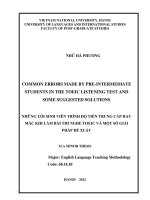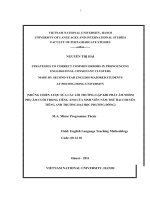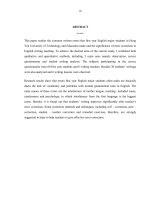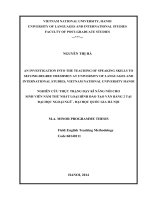Luận văn thạc sĩ Luật học: Nghiên cứu một số lỗi phát âm thường gặp của sinh viên năm thứ nhất chuyên ngành Tiếng Anh trường Đại học Luật Hà Nội và một số biện pháp khắc phục
Bạn đang xem bản rút gọn của tài liệu. Xem và tải ngay bản đầy đủ của tài liệu tại đây (32.56 MB, 82 trang )
MINISTRY OF JUSTICE MINISTRY OF EDUCATION AND TRAINING
HANOI LAW UNIVERSITY
LE QUYNH CHI
443031
AN INVESTIGATION INTO SOME COMMON
PRONUNCIATION MISTAKES MADE BY FIRST-
YEAR ENGLISH-MAJORED STUDENTS AT HANOI
LAW UNIVERSITY AND SOME SUGGESTED
STRATEGIES TO COPE WITH
Hanoi - 2023
MINISTRY OF JUSTICE MINISTRY OF EDUCATION AND TRAINING
HANOI LAW UNIVERSITY
LE QUYNH CHI
443031
AN INVESTIGATION INTO SOME COMMON
PRONUNCIATION MISTAKES MADE BY FIRST-
YEAR ENGLISH-MAJORED STUDENTS AT HANOI
LAW UNIVERSITY AND SOME SUGGESTED
STRATEGIES TO COPE WITH
Major: English Language
Hanoi - 2023
DECLARATIONS
I hereby state that I: Lê Quỳnh Chi- student code 443031, being a candidate
for the degree ofBachelor ofArts accept the requirements of the University relating
to the retention and use ofBachelor’s Graduation Paper deposited in the library.
In terms of these conditions, I agree that the origin of my paper deposited in
the library should be accessible for the purposes of study and research, in
accordance with the normal conditions established by the librarian for the care,
loan or reproduction of the paper.
Supervisor Student
Tran Thi Thuong Le Quynh Chi
April 4", 2023
ACKNOWLEDGEMENTS
First of all, I would like to acknowledge the great assistance of my
supervisor, Mrs. Tran Thi Thuong. I am very grateful to her for all the help she has
kindly given to me. She has always provided helpful comments, and support for my
thesis whenever I needed it. I would never have completed this thesis without her
kind help.
Additionally, I owe a special debt to all my research subjects that are first-
year English major students at Hanoi Law University for giving their time and
enthusiastic participation during my data collection. I wish to express my respect
and most grateful thanks to Foreign Language Department, especially the English
team for their support during my study.
Above all, I owe my greatest debt and most heartfelt thanks beloved family
and my dearest friends for their support, patience, and active encouragement.
Without all of which, my thesis would have not been possible.
ABSTRACT
This study investigated the common pronunciation mistakes made by first-
year English-majored students at Hanoi Law University and suggested strategies to
improve their pronunciation. This study adopted a mixed research design, including
both quantitative and qualitative data, and used voice recording to find out a deep
insight into the pronunciations that students made. The study utilized pronunciation
tests and questionnaires to collect data from 30 students. The findings indicated that
students struggle with vowel and consonant sounds as well as suprasegmental errors
such as word stress and intonation. Additionally, the study found that Vietnamese
students frequently mispronounce specific ending sounds. Furthermore, to
supplement the data gathered from the pronunciation test, a survey questionnaire
has been designed specifically for Legal English Department lectures at Hanoi Law
University. The questionnaire aimed to gather information on the most common
mistakes made by first-year students in their pronunciation of English as well as the
most effective methods for improving it. In order to collect information on the most
effective methods for improving English pronunciation, a survey questionnaire for
students has been developed. The study showed the most effective method for
improving pronunciation, according to both students and teachers, was watching
movies and TV shows in English. The study provided practical recommendations
for teachers to design effective teaching methods and materials to help students
overcome their pronunciation difficulties.
TABLE OF CONTENTS
I?)2697P77.1./7.4M16910.7 1 Sa... 1...1... ii
ACKNOWLEDGEMENTTỀ.......c6.5.S...c ..ọ ....0 .... 0.00.005.000.008.008 iii
ABSTTRRACCTT........................... o5 << 5< << 4 9...0... c0 0 00 0000000004. 0000400004009 6 004.00 iv
LIST OF TABLES AND EIGQURES siscssssvssesessssersvnansnnssssvanssesavaunsssosavensoaeasaseswnns viii
LIST OF ABBREVIATIONS. ssccassssssscssssscscscnansvc0o6n15s50s81a0s38s55s0e58s75n58s5c00o60n08s⁄t8Ee58s5 x
INTRODUCCTTION..........6<.G .G ....0 ....0 ....8 ..... ....00.040.000.040.00o090 1
1, Rationale for the SEUỦY cess cnsecexena eoemncec ncx e nmoonr teenE cR coE s 1
Jo Äis OF the SHUDY sssscascesssessvevensnsossscessvevesersnssarssavenssecersssssnancessssveseonnscsaevecsvesseoenate Zz
3. Scope Of the SỀUỦY........S.5.5 5 . 9.....0.......0. .00.. .00.00.00.00.00.4 0G00G 800G06G 060G08 2
4 PTS TL CH! NEITTỸ secccocosmnsumnonenenononnacesnnecemensoansne nnarennontonaenesoecmemenonencena 3
3. Methods for TH Study ssssscscncancssmnesecensvensnvennsesecasntionsnerounnenvonanstsennnnanasronnsnonens 3
6. OF Gani zation 0Ï The SUA Y 8 oc sis cis scrssssscsccsscssasvesrecsaxesrsesscssessscssssenvscsveseansssecceaesesses 4
CHAPTER 1: LITERATURE RELHV YN............... Go HH. 0009008096 5
1, PR CIP GIO xeseeseseaesennnoarionnndinntodriinoriG0I0n00900008158800009900E49000E010/100050E0000/050100858 5
1.1. DelHf[OHsssssesnseonaveennnnaeiitirnidliiiiist0i10010007951961090840000/0E0015093/5000543170090/-KSE40 5
1-2. Thé iporlanee Of pfointiổlatlofisesessaenaaaasselivostiaiodiNEkdigG0005003009010551615806586 6
2. The Features of Prdnelr[DH econo orem eee 6
ol, Ties ST) Te 7 5611 ... 1 racaerARRN. A RIRCRR. ERERRRE. RNCRER 7
2.1.1. PHOHCHGIS cesses cnnececnercnsncxcescensinnanesconneeanconnekes aunecennvesmavinenaneonssmannenneoneanceen 9
2,12, Hiiglish Vowels cis: eeeiesmanciei armenia 9
2.1.3. English Consonant ........ccsccssscsssscsssscsssscscccsscscsccscscesssscsssccssscsssscsessesssesees 10
2.25, SUPTASSRMEHtA] TREATIES xcs cece nine NONE NRTR RA NR KER RRORNAAN DEERE 11
2.2.1. Litt scassscscsscnessssncansvsserssssensesavasastsaxssaccassvessssseeasaasvasanasasanassecsseneasstas 12
2.2.2. IMtONALION.......ssccccrccssccessscssccssccssssesssecssscsssscsssscssssensssssssssssssesssssssessesesesees 12
“8Ÿ... 5©.... 12
3. Factors Affecting Pronunciation LearnÏnÐ..................<.<.<.< s.5.5.s.s.e<.ss.ee.s.ss.ee-es-e 13
3.1. Native Language of Mother TÍGHETHB soesesseeeaesdstinioasaskitvoyGEEEEEVCEIEGE4455665665ã68 13
Didi TU bgiig%185.66575055565009090584501004568061 000080 -05 608807ã6163i2709880686135-33700050508000855440588595400000G68 13
3.3. Language transfer (from first language L1 to second language L2).............. 14
ULC) ene 14
3.5.. HHWVIFGTHTiGHE sassvcssassasasanssousnesassvansssvanssesssssancaanessnnsesnssuannssexssnennsssassomensomssvessses 14
3.6. Physical LIITIẨA{IOTNS...................d có 6 5 5 9999 9 9999 9 99999 999.9 9999.99.09 09005.98 8984 96 14
4. Errors and Mistakes scsssssescscsssnsencenswsnennsincssninenesennensonnonscsnsenoresnnncenncennecsnensess 15
3. Related Stdits. ssssssssssnscsssssscomsssvsmnneneannnsunsiomanssoumeaennsrevannncecnenseemacasnsneasavae 16
3.1. COT OH AS TT TT DfEssssesnesriginsaBA4016041336151300511488k35A8ã055566518664803455505567756ã618800085006168 17
5.2. Vowels TTIISfAÏKCS................... o5 << 5 5 9 9 9.9.0.0... 4...0 0.00004006004008 20
SE svusnetithngtkiginitintgtRGIGTTDBG0RDTGUSGIEDSEHSONRHIGUENNWE-NGEIRGDEIUEDVGGIEDISEENERGIENEEAĐS0M0084009000010 22
5.4. THỈOHÍØTiusnsuennieiarndiiEDGEEASENSEKER10000458501148613578855854085568680215995089958604000450810510988/2006 a2
5.5. Word StLeSS .......ssccscscccsecsssecsssecsscesccsscscenccsesccsesssscnsesssssscessscssencesencsscsessessseneee 22
6. Chapter SUHHẨHTY soeeeeeaeeeerniennatiiinniasiisassynooEAKEESGESESE401600/9601000015405N0445045000004 23
CHAPTER 2: METHODOLOGY sssssssssssssssssssscsavseavesvssasscesssussvusesresearsonssvurssssaveses 24
1. Design of the Study .........5.<.< G . G5 .<< .S9..9........H. ọ ..0....00.08.000.000.8.06.08 24
go say apencresssesrkeesteeeieerravsetsrxootitiei003610910412340191001286062091901001945509094%451%144016052650I04 24
3. Data collection instruments and Procedures ..................55.5.5.<.<..5 .5 5.5.55.3.3.99.9.5 25
3.1. ProHiiolatlofHi TGBGaweaweanasssiasdirtiontestrstsitbkistreSyNSEEG0TEMEEEIWSESWS0054619550508550/4 25
3.2. Questionnaire fOr SfUTIẨS...................... << << << << 6% 95% 899949495989999999489398999595959669995665669 25
3.3. Questionnaire for Teacher ...... << ss.s56.9. 555. 8999. 4949. 99899. 9999. 8994. 59999. 9995. 9965. 96899. 9566c 8868 26
4. Data AnalSIyS cancgnaanngiatiitdataaiiSg0i5110166601885006080666505004885840066605668008586865505445988544 26
4.1. Qualitative Anal S18 csccccsachn ấn cGgs sti8s .ã8w .060c 000w 0008s 636s 0588e 803s 01%.s g6us .ố/0s 80ãr .108s 068 26
4.2. Quantitative Analysis .....ccscccccssscscssscccsssccsssscccsssccssscssssscscsssssssssscssssssssssesess 26
5. Chapter SUMMALY .......................... o5 G5 5< 5 5 99. 9...9. 0...0 0...0 00009060098 90 27
CHAPTER 3: RESULTS AND DISSCUSION ...............0..G..S.o.n....1.1.s..,28
1. Question 1: "What are the common pronunciation errors made by first-year
English-majored?" (Finding from questionnaires and the pronunciation test) 28
2. Question 2: "What strategies should be taken by first-year English-majored
students to improve their pronunciation?" (Findings in the questionnaires) ...39
3. Chapter SUMIIIALYsa nsncmnencnencnomeneannenennmcenenencunnmeamaneaneenneuenee 51
CONCLUSIONN............................. 0G G0 HH TH 0 0 000000009 004. 00.0609 684 52
L, Summary of re main TT THDSseesesensnseseornseernnntnoennoroonorggpnnpgtrtpoovesingpetnfinnessee 52
2. Implications and recOMMEeENAAtiOns ..............--.- <.<.55.<.<.5 5..<.9.S..5.55.5.95.55.82.5 53
2.1 Reeornreridatioris fot SHICHI wcsseswasccnvacswsovassnesassswenns crcunsceneanenssaaseacensseacnenane 53
2,2, Recommendations fof T6dchett.wsmcsmcassiosmnnnnannmaciniummamunases 54
3„ Limitation, of te SEHỦY cocaxsce onn cencsce onecs enrn to ne eon m noEe ReNa EREm OENe ERNn NS 54
REFERENCES isssersssosssensssusensscanenssussxnsvacexsvsasanenenscsineniassnuvnsaenenscsnsnisveneneiseasavanmnsaenes i
Appedix I: Pronunciation Test for SfuC[€TIfS..............o.5...<.5.5 5..5.5.5.5.5.9.5.9.9.5. iv
Appendix II: Survey questionnaire for SfU[€TIÉS...................c.5.55.5..<.<.5.5 5..5.5.5.9.5. vi
Appendix ITI: Survey questionnaire for lectures .....................5.5..<.5.5.5.<<.<-< .s.e.ee.s.+ xi
vii
LIST OF TABLES AND FIGURES
FIGURES
Figure 1. Features of English pronunciation (Burns, 2003).........................------«++++
Figure 3. Subdivisions of the tongue (Roach 2000)..........-.-..- .5.S.< .+ .+.+s.sv.es.ss.ee.er.ee.ee-e 8
Figure 4. The articulation of vowels (Kelly, 2001).........cccccccesccecssseceesteeeesseeeesseeeeeees 9
Figure 5. Vowel mistakes made by students (N=30) .........eceececceeeeteceeeteeeeeneeeeseneeees 28
Figure 6. Teacher's beliefs in the difficulty of vowel sounds (N=10)...................... 29
Figure 7. Consonants mistakes made by students (N=30).........................S ..-2 --- 31
Figure 8. Teacher's beliefs in the difficult of consonat sounds (N=10).................... 32
Figure 9. Ending sounds mistakes made by students (N=30)...........................--.---~-- 34
Figure 10. Teachers' beliefs about common pronunciation mistakes made by
J0 S0) C0 0 .................................. 37
Figure 11. Methods used by first year students to improve pronunciation (N=99)..42
Figure 12. Teachers'thought about the Methods students should use (N=10).......... 42
viii
TABLES
Table 1. Chart of English consonant phoneimes...............-.--.s .+..ss.++.+.++.se.e.x+.ee.x.+s-ss-2 10
Table 3: Manner GỀ Sr CO Oth ss nen scunnggn nà ga ùn thì Ha G8108 san ncna HỘ GB) H81 Rann ABA ORDA ARI II
Table 3. Place of arfICuÏafIOTI.......5.6..s6..11.63.11.1.1.19.11.1 .9.11.9.1.H ....H ...- 11
Table 0/10 c 0 . .e..............Ả....- 26
Table 5. Number of stundents mispronounced vowel sounds (N=30)........................ 29
Table 6. Number of students mispronounced consonant sounds (N=30)................. 32
Table 7. Number of students mispronounced ending sounds (N=30)..................... 36
Table 8. Students common mistakes in pronunciation (N=30)..........................-------37
Table 9. The importance of good pronunciation for learning English (N=99)......... 39
Table 10. Descriptive Statistics of the importance of good pronunciation for
learning English 0) 0... 40
Table 11. Frequency of learning and practicing pronunciation (N=99)..................... 41
Table 12. Descriptive Statistics of the frequency of learning pronunciation by
9991911116)16:1511500ÀI-5201010087. “da... . .4I
Table 13. Descriptive Statistics of the Frequency of the methods (N=99)................ 43
Table 14. Descriptive Statistics of the effectiveness of the methods (Students)
S44 ........................... 45
Table 15. Descriptive Statistics of the effectiveness of the methods (Teachers)
00 ...................................... 46
Table 16. The level of efficiency of the methods (N=99)...................5.25.c.s.s+.+.<.ss.s.+s-s-s 47
HLU LIST OF ABBREVIATIONS
LI : Hanoi Law University
L2 : First Language
GG : Second/ Foreign Language
INTRODUCTION
1. Rationale for the study
In recent years, there has been an increasing demand for English language
proficiency around the world. As society continues to develop, it has become more
necessary than ever to be able to communicate effectively in English. In order to
communicate effectively, it is crucial to have good pronunciation. Salikhova (2020)
argued that pronunciation is the most important and difficult problem that non-
native speakers face when learning a foreign language. Improper pronunciation can
lead to negative impressions, misunderstandings, and ineffective communication.
Salikhova also emphasized that, in real-life conversations, pronunciation is the first
thing noticed, and people will quickly determine if someone has good or bad
pronunciation. Even with a limited vocabulary, good pronunciation is critical for
effective communication, and a strong foreign accent can overshadow good
grammar and vocabulary skills. Pronunciation is particularly important for non-
native speakers, who may struggle to be understood even if their grammar and
vocabulary are correct. Therefore, it is essential to address pronunciation as part of
language education and practice. Duong (2009) claimed that Vietnamese people are
generally good at grammar and do not make many grammar mistakes. However,
they tend to have a different attitude towards pronunciation mistakes, which are
often considered less important and not given much attention.
Recognizing the importance of correct pronunciation, this study will focus
specifically on improving speaking skills, with an emphasis on pronunciation. The
researcher has chosen to conduct a study on the common pronunciation mistakes
made by first-year English majors at Hanoi Law University. Although there have
been many research papers at Hanoi Law University on the topic of pronunciation,
no one has yet mentioned the mistakes that English students often make. The
researcher has observed that many students struggle with pronunciation, which can
lead to misunderstandings and difficulty communicating with native speakers.
Furthermore, many students are not aware of the specific sounds they are
mispronouncing, and they may have trouble learning and practicing proper
pronunciation. Therefore, this study aims to identify common pronunciation
1
mistakes and provide suggestions for improving pronunciation skills so that
students can communicate more effectively in English.
For the reasons mentioned above, the author decided to choose the topic "An
investigation into some common pronunciation mistakes made by first-year
English-majored students at Hanoi Law University and some suggested strategies
to cope with" to find out the pronunciation errors of first-year students at Hanoi
Law University.
2. Aims of the study
This research aimed to investigate common pronunciation mistakes made by
first-year English major students and the methods that should be taken to improve
pronunciation at Hanoi Law University. Specifically, this research aimed to obtain
two objectives. The first objective was to identify the typical English pronunciation
mistakes made by first-year English major students at Hanoi Law University. The
last one was to give some solutions to improve the English pronunciation learning
of students at Hanoi Law University.
In order to achieve the above-mentioned objectives, this study focused
on two research questions:
(1) What are the common pronunciation errors made by first-year English-
majored?
(2) What strategies should be taken by first-year English-majored students to
improve their pronunciation?
3. Scope of the study
The study focused on surveying K47 freshmen majoring in English. This
study focused more on researching and identifying the pronunciation mistakes
related to English pronunciation than on speaking skills. Through their involvement,
the study will be able to investigate the pronunciation errors and suggest appropriate
methods to address these issues. Due to the constraint of human capacity to deal
with a great amount of data within the time limit, the theoretical framework for this
research will be merely based on certain features of pronunciation, such as vowels
and consonants in English, as well as intonation, linking, word stress.
4. Significance of the study
The study on the concentration of learning English pronunciation for
students at Hanoi Law University is of great importance for several reasons. Firstly,
it aimed to provide insights on the crucial role of pronunciation in the process of
learning English, which is an essential language for academic and professional
success. Secondly, the findings of this study can be utilized to develop effective
teaching strategies that can improve English pronunciation skills among students,
thereby enhancing their overall language proficiency. Thirdly, the study results can
be shared with other institutions and educators to promote a greater understanding
of the significance of pronunciation in language learning. Additionally, the data
collected from this study can serve as a valuable resource for future research on
English language learning and pedagogy in Vietnam and beyond. Therefore, this
study has the potential to contribute significantly to the field of English language
teaching and learning, and can help pave the way for further research and
development in this area. This study is important because it addresses a critical
aspect of language learning: pronunciation. By identifying common mistakes made
by English learners and providing guidance on how to improve pronunciation skills,
this study can help students communicate more effectively in English and achieve
their academic and professional goals.
5. Methods for the study
In order to accomplish the objectives outlined above, this study adopted a
mixed research design that includes both quantitative and qualitative data. A
pronunciation test was used to collect thirty participants pronunciation mistakes.
This test served as the main instrument for detecting errors in the students' English
pronunciation. The test was conducted at Hanoi Law University, with the researcher
personally recording the students.
Furthermore, to supplement the data gathered from the pronunciation test, a
survey questionnaire has been designed specifically for Legal English Department
teachers at Hanoi Law University. The questionnaire aimed to gather information
on the most common mistakes made by first-year students in their pronunciation of
English, as well as the most effective methods for improving it.
Finally, in order to collect information on the most effective methods for
improving English pronunciation, a survey questionnaire has been developed. This
questionnaire will be administered to K47 English-majoring students at Hanoi Law
University. By gathering their insights and experiences in the hope of gaining a
more comprehensive understanding of the issue at hand and developing more
effective strategies for improving English pronunciation among first-year students.
6. Organization of the study:
Part A, Introduction, presents rationale, objectives, research questions,
scope, methods, significance, and design of the study.
Part B, Development
- Chapter 1, Literature Review sets out the theoretical framework for
research and reviews some of the earlier studies.
- Chapter 2, Methodology provides the design of the study, participants,
data analysis.
- Chapter 3, Findings and Discussion shows the analytical findings of the
of the data obtained.
Part C, Conclusion provides summary, limitations, implication and
recommendations
CHAPTER 1: LITERATURE REVIEW
In this section, previously conducted research in the detail fields of
pronunciation will be presented and discussed. This must be done in order to place
the thesis in the relevant context for the research that will be conducted.
Furthermore, it will provide the readers with some basic knowledge of the
background and present state of this field of research.
1. Pronunciation
1.1. Definition
Pronunciation is the process of pronouncing a word or language. It is not
easy to learn English pronunciation as a second language. According to Dalton, C.,
& Seidlhofer, B. (1994), pronunciation can be defined as the production of a
significant sound in two senses. Initially, sound is significant because it is used as
part of a specific language's code. In this sense, we can define pronunciation as the
production and reception of speech sounds. Furthermore, sound is significant
because it is used to convey meaning in various contexts. Here, the code interacts
with other factors to enable communication. In this sense, we can discuss
pronunciation in terms of speaking acts. Harmer (2007) explained that
pronunciation refers to how we make language sounds, where and how we place
stress, and how we use pitch and intonation to convey how we feel and what we
mean. According to the Adult Migrant English Research Center (2002, as cited in
Ly Bui, T., Mai, T., & Diep, H., 2021), the production of sounds that we use to
make meaning is referred to as "pronunciation." It includes paying attention to the
specific sounds of a language (segments), aspects of speech that go beyond the level
of the individual sound, such as intonation, phrasing, stress, timing, and rhythm
(suprasegmental aspects), how the voice is projected (voice quality), and, in its
broadest definition, paying attention to gestures and expressions that are closely
related to how we speak a language. Furthermore, the Oxford Advanced Learner's
Dictionary defines pronunciation as "the way a language or a particular word or
sound is pronounced."
This study will use the definition provided by the Oxford Advanced
Learner's Dictionary because the study will identify mistakes made by students
when pronouncing a specific word or sound in English.
1.2. The importance of pronunciation
Pronunciation is important because it affects how well a speaker can be
understood by others. If a speaker's pronunciation is poor, it can lead to
miscommunication, confusion, and even frustration. In addition, pronunciation is
also an important aspect of language learning. Learning proper pronunciation can
help learners communicate more effectively and confidently in their target
language. It can also help them better understand native speakers and improve their
overall language skills. O’Connor (1980) stated that "the main problem of English
pronunciation is to build a new set of boxes corresponding to the sounds of English
and to break down the arrangement of boxes which the habits of our native
language have so strongly built up. We do this by establishing new ways of hearing,
new ways of using our speech organs, and new speech habits". Furthermore,
according to Burns (2003), clear pronunciation is essential in spoken
communication. Even if students make minor mistakes in their vocabulary and
grammar, they are more likely to communicate effectively if they have good
pronunciation and intonation.
As a result, in order to improve their English-speaking skills, students should
practice their pronunciation every day.
2. The Features of Pronunciation
The features of English pronunciation are adapted from the book Clearly
Speaking - Pronunciation in Action for Teachers by Burns, A., Claire, S. (2003).
Figure 1. Features ofEnglish pronunciation (Burns, 2003)
FEATURES OF ENGLISH PRONUNCIATION
| |
Segmental features |
Suprasegmental features
|
Phonemes Linking Intonation Stress
(Sound differences within a language)
| | | |
|
Vowel sounds Sentence stress Word stress
Consonant sounds
rR Voiced
Unvoiced Single Diphthongs
—]
Short Long
As the diagram above illustrates, pronunciation involves features at:
* the segmental (micro) level
s the suprasegmental (macro) level
2.1 The segmental features
According to Roach (2000), all of the sounds we make while speaking are
caused by muscles contracting. The breathing muscles in the chest produce the flow
of air required for almost all speech sounds; muscles in the larynx produce many
different modifications in the flow of air from the chest to the mouth. After passing
through the larynx, the air enters the vocal tract, which terminates at the mouth and
nostrils. Air from the lungs escapes into the atmosphere. We have a large and
complex set of muscles that can change the shape of the vocal tract, and it is
necessary to become familiar with the different parts of the vocal tract in order to
learn how the sounds of speech are produced. These various parts are known as
articulators, and the study of them is known as articulatory phonetics.
The diagram below represents the human head seen from the side and shows the
articulators.
Figure 2. The Articulators (Roach 2000)
nose Pin h hard soft palate (velum)
alveolar ridge palace
upper lip
lower lip
pharynx
lower teeth
larynx
The figure describes the different parts of the mouth and throat that are involved in
producing speech sounds. The pharynx is a tube-shaped part of the throat that
connects to the back of the mouth and the nasal cavity. The velum, or soft palate, is
one of the articulators that can be touched by the tongue, and it can be raised to
prevent air from escaping through the nose during speech. The hard palate is the
"roof of the mouth" and has a smooth, curved surface that can be felt with the
tongue. The alveolar ridge is a bumpy surface between the top front teeth and the
hard palate, and sounds made with the tongue touching here are called alveolar.
The tongue can be moved into many different places and shapes and is divided into
different parts such as the tip, blade, front, back, and root.
Figure 3. Subdivisions of the tongue (Roach 2000)
; blade front back
up
root
The teeth are important for making speech sounds, and sounds made with the
tongue touching the front teeth are called dental. The lips are also important and can
be pressed together, brought into contact with the teeth, or rounded to produce
different sounds. The seven articulators described above are the main ones used in
speech, but the larynx and jaws also play a role, and the nose and nasal cavity are
important for nasal consonants.
2.1.1. Phonemes
Phonemes are different sounds in a language. Although there are slight
differences in how individuals produce sounds, phonemes reasonably describe how
each sound is made. Sounds are divided into "voiced" and "unvoiced" (sometimes
referred to as 'voiceless'). Voiced sounds occur when the vocal cords in the larynx
vibrate. It's easy to tell if a sound is voiced by putting a finger or two on the Adam's
apple. The vibrations occur when making a sound with a voice; with a voiceless
sound, the larynx will not vibrate. Phonemes include vowel sounds and consonant
sounds. Consonants can be voiced or voiceless. It is possible to define many pairs of
consonants that are essentially the same except for the voiced element (Kelly,
2001).
2.1.2. English Vowels
All vowels are voiced and can be singular (such as /e/, as in let), or
combined, involving movement from one vowel to another (such as /ei/, as in
"paid"); such a combination is called a diphthong. An additional term used is
triphthongs, which describes the combination of three vowels (like /aua/ in
"power"). Single vowels can be short (like /1/, as in ship) or long (like /1:/, as in
sheep). Vowels are formed when the airstream is voiced by vibrating the vocal
cords in the larynx and then shaped with the tongue and lips to change the overall
shape of the mouth. The position of the tongue is a useful reference point for
describing the differences between vowel sounds, as illustrated in the diagram
below (Kelly, 2001).
Figure 4. The articulation of vowels (Kelly, 2001)
Front Centre Back
\ Close \ j; \ u:
I
2:
Mid \e
D
A
ai
œ
Open









